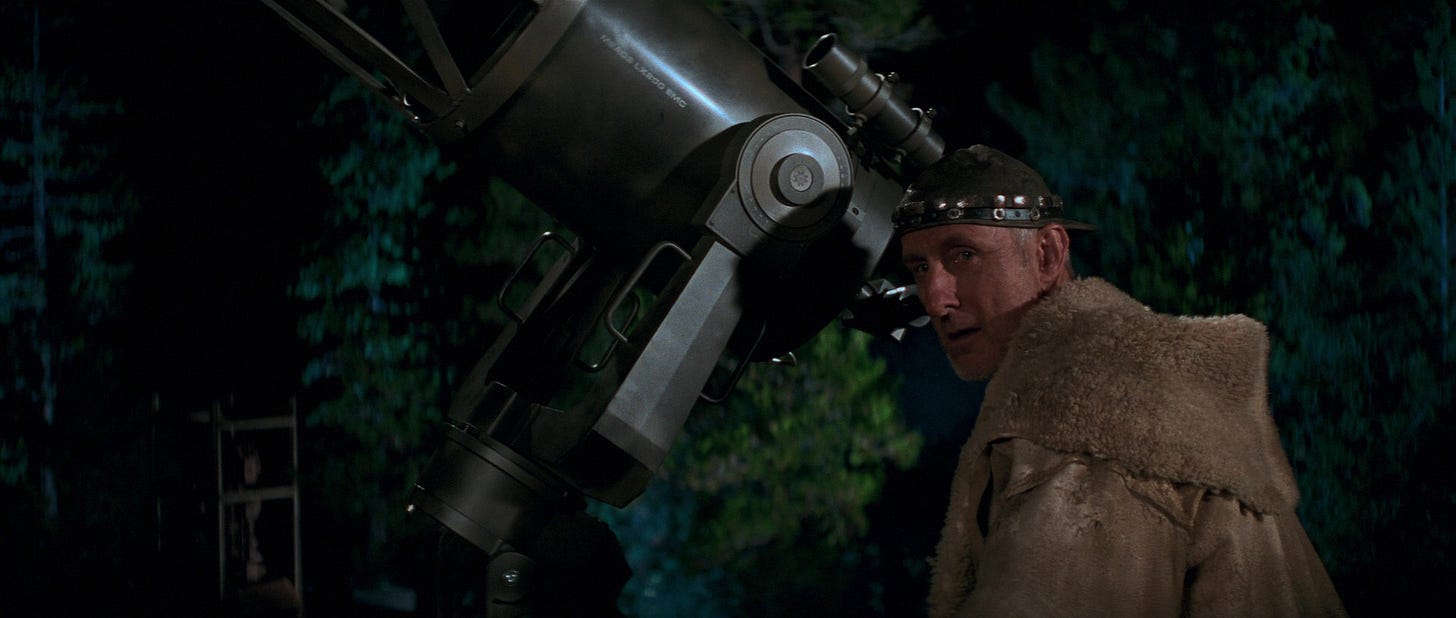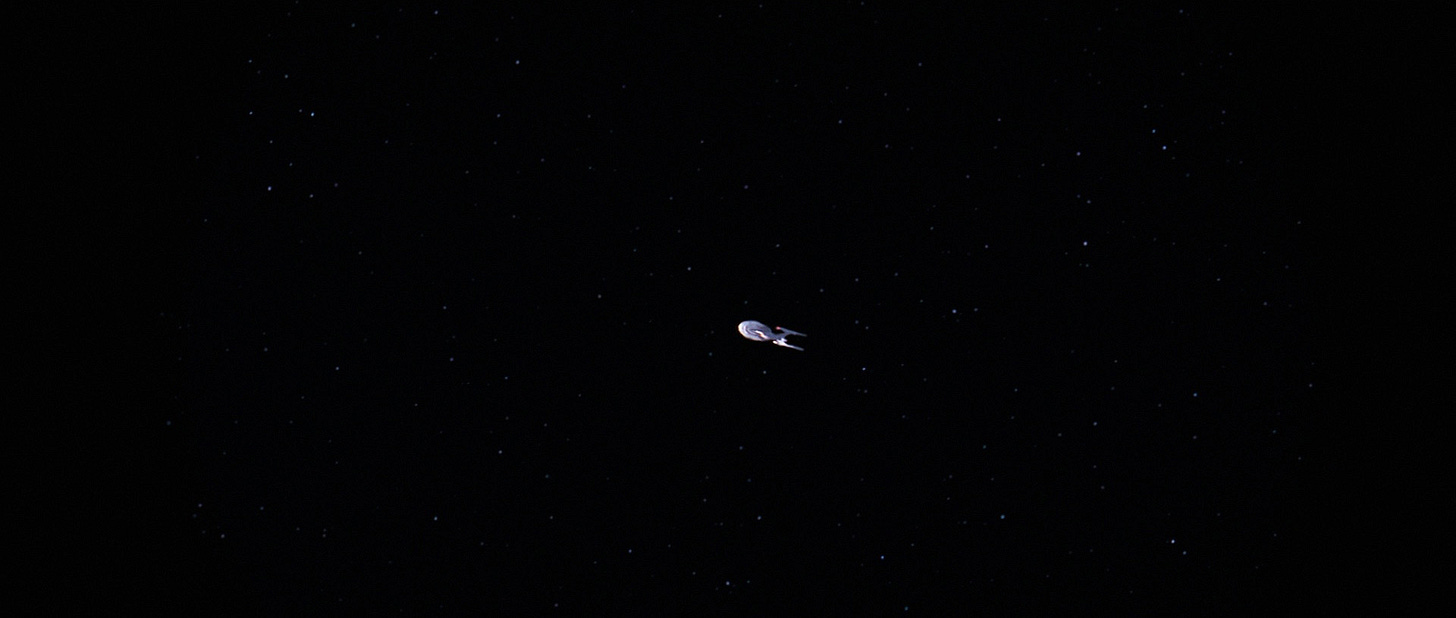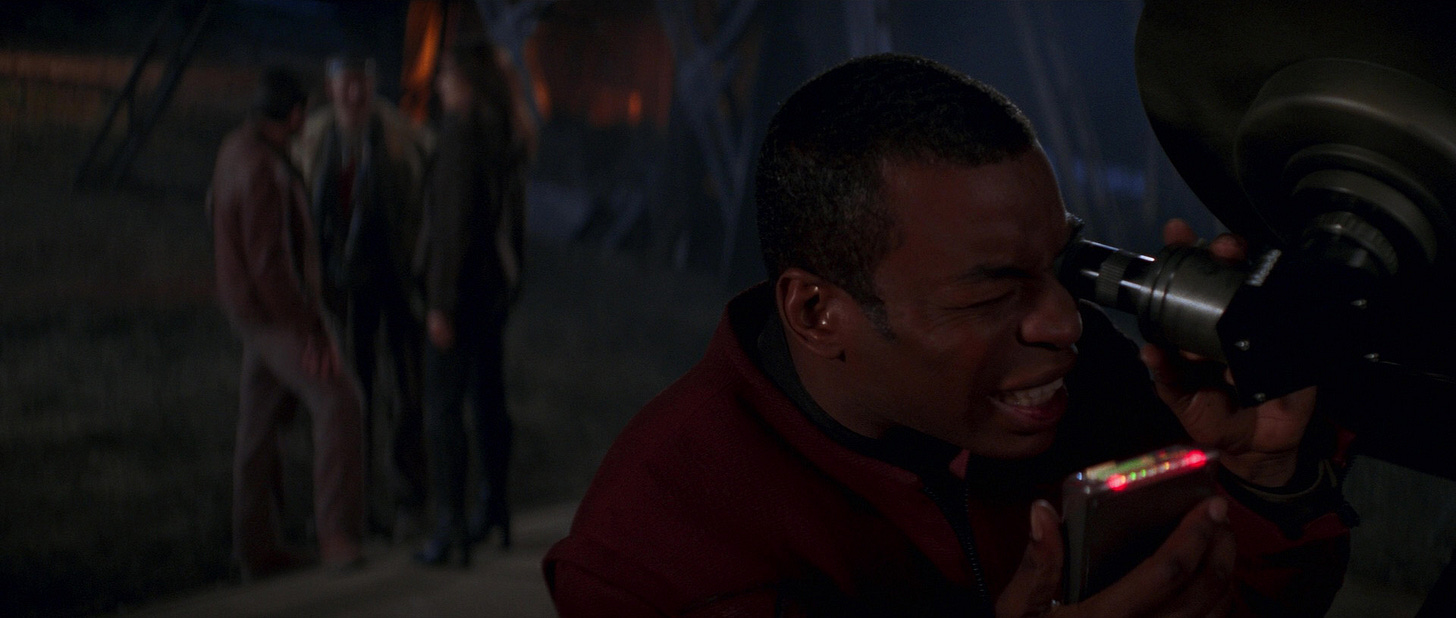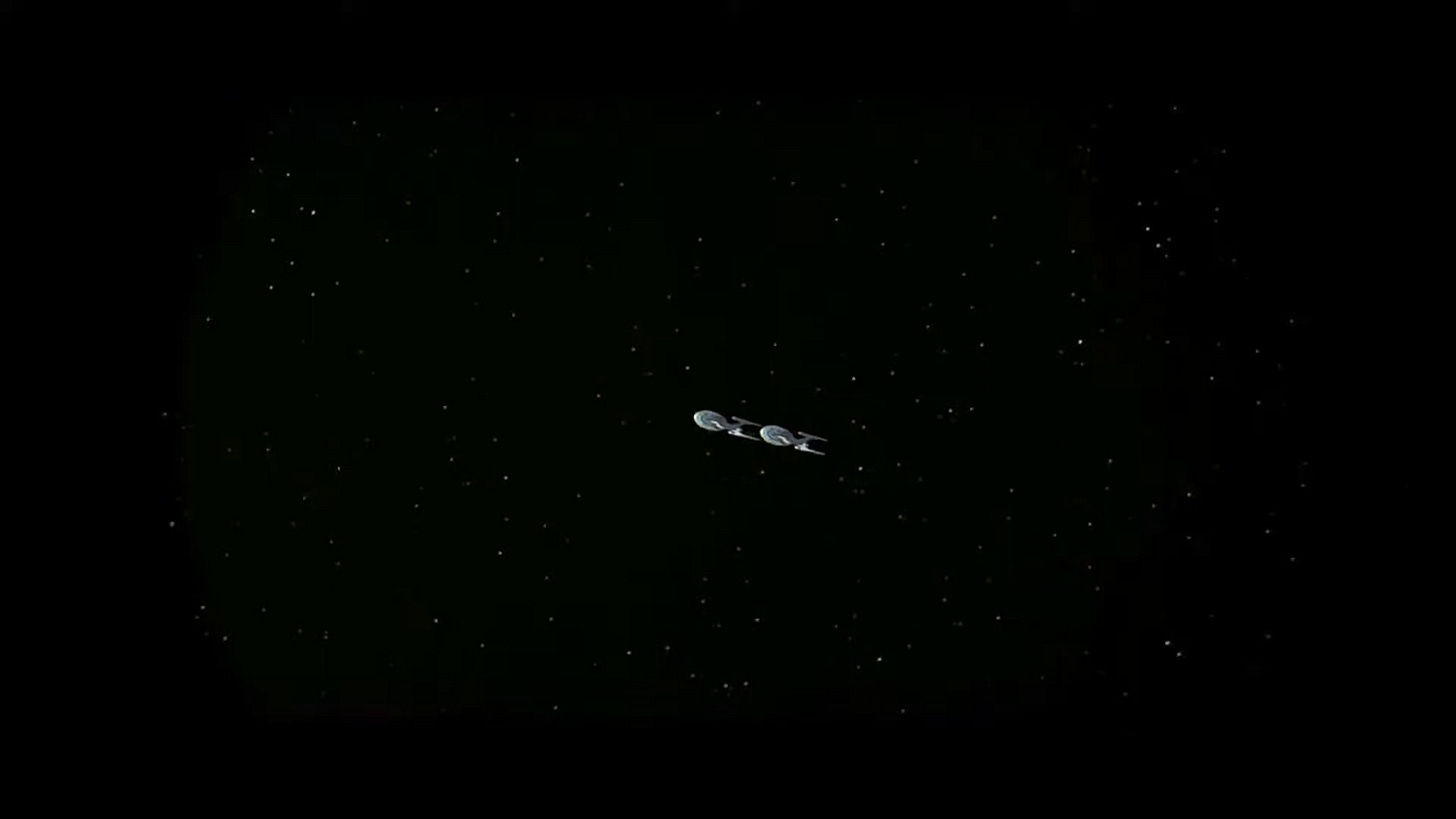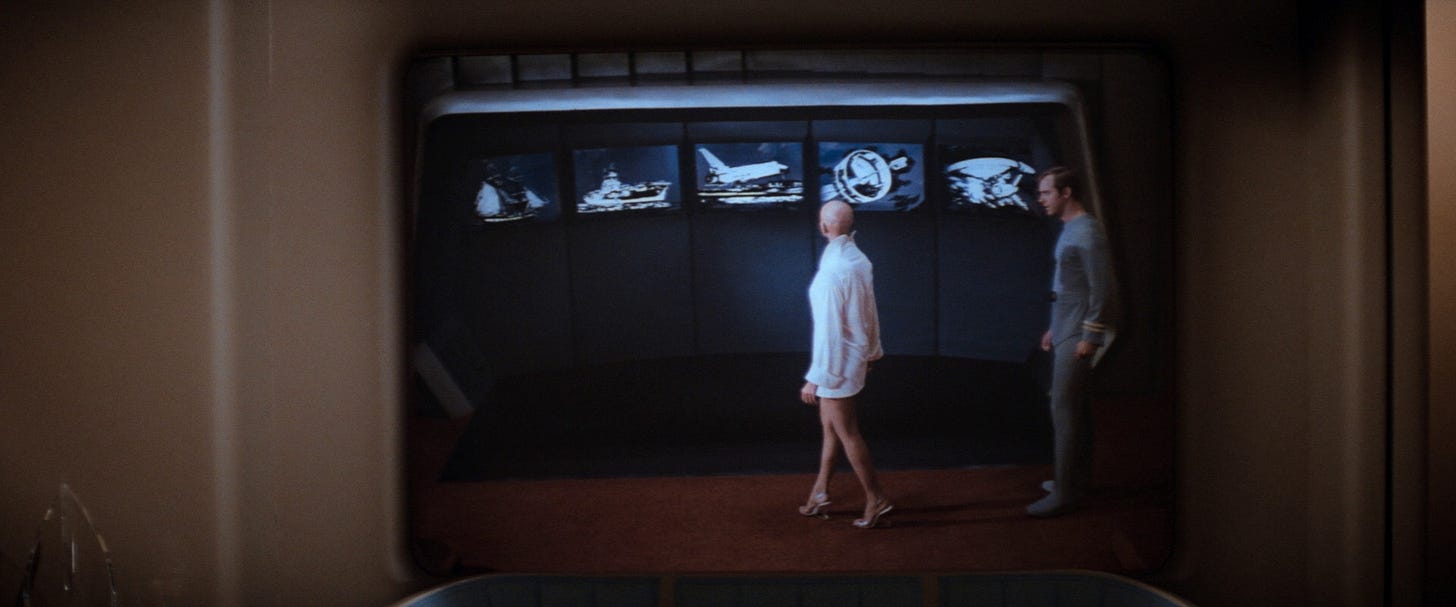What Cochrane's Telescope Reveals About The Enterprise
An analysis of astronomy in Star Trek: First Contact
In the eighth Star Trek film, First Contact, warp drive inventor Zefram Cochrane observes the Sovereign-class U.S.S. Enterprise (E) using a telescope aimed by Geordi La Forge.1 This observation was used to persuade Cochrane of the Enterprise’s authenticity, but there is some doubt whether resolving the Enterprise with such equipment would even be possible. With some knowledge of the optics of Cochrane’s telescope, it is possible to infer the speed and altitude of the Enterprise and assess if they are reasonable.
Identifying the Telescope
His telescope is marked as a Meade LX200 EMC, a commercially available Schmidt-Cassegrain telescope from the 1990s. Being one of the earliest computerised telescopes, this must have seemed quite futuristic, although it is doubtful that the classic series (EMC) of LX200s would survive past the third world war.2 The production team have weathered Cochrane’s telescope and added a trussed extension, suggesting it has been upgraded beyond its 1990s specification. The LX200’s instruction manual is undated, but contains a commendable volume of data including telescope specifications; catalogue of objects and explanations of magnification and field of view.3
Problematically, there are at least seven types of LX200 EMC, with there being few distinctions beyond size to distinguish them. We can preclude Cochrane’s telescope from being the 16” LX200, based on the size of the declination setting circle.

While I have not found adequate documentation of Meade’s telescopes, such as a 1990s product catalogue, Cochrane’s telescope seems to most closely resemble the 12” LX200 f/10 telescope.
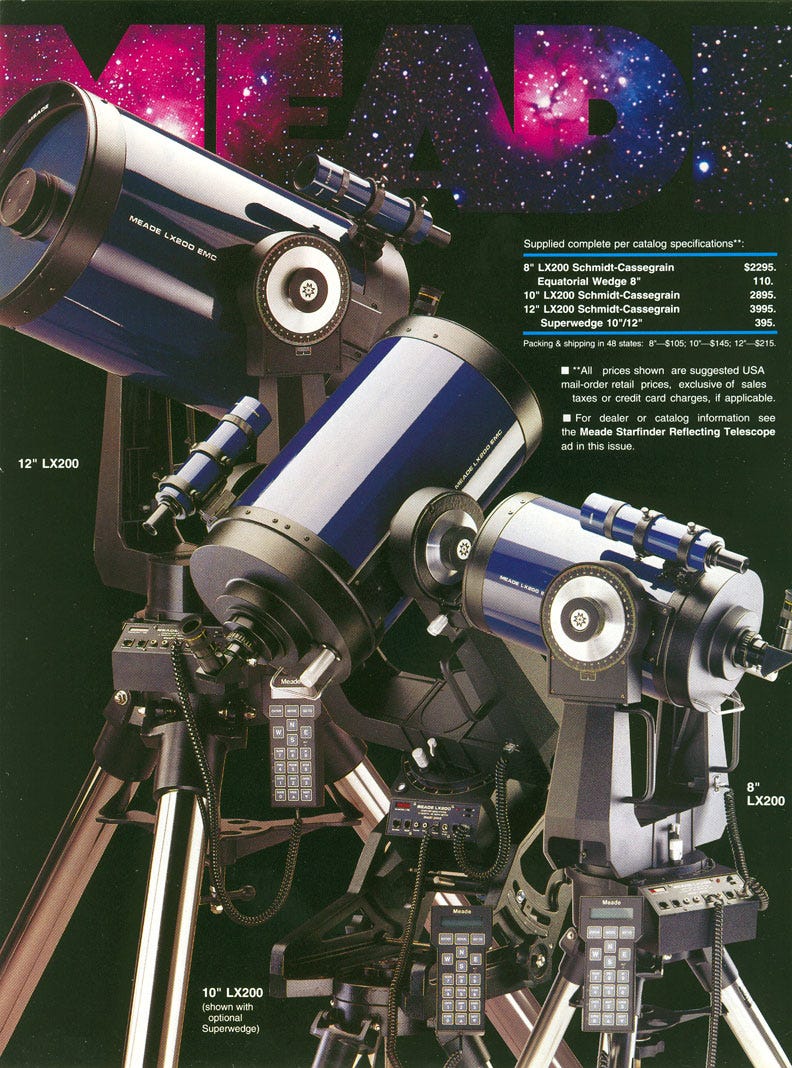
Fortunately , the 12” LX200 f/10’s specifications are included in the LX200 instruction manual. (The 16” specifications are omitted.) I shall be proceeding using the LX200 specifications, rather than speculating on what the capabilities might be for a modified telescope and so caveat my conclusions as such.
Calculations
Altitude Estimate by Field of View
The Enterprise appears remarkably undistorted through Cochrane’s telescope; even an ideal telescope can not possibly be so clear when one has to contend with atmospheric refraction.
In the above screencap, the field of view has a diameter of about 1561 pixels. The Enterprise measures about 92x43 pixels, therefore having an approximate length of 102 pixels (by Pythagoras’ theorem.) It spans about 7% of the field of view.
To determine anything further about Enterprise, we need to know the field of view of Cochrane’s telescope. This can be calculated with the telescope’s magnification, and the apparent field of view of the eyepiece.
Telescope magnification is the ratio of objective focal length to the eyepiece focal length.
The objective focal length for the 12” LX200 is listed in the comprehensive instruction manual and is 3.048 metres. The instruction manual also states that the eyepiece is a Series 4000 SP26mm eyepiece. Assuming Cochrane is also using that eyepiece, this gives us the eyepiece focal length of 26 mm. The manual provides the eyepiece’s apparent field of view as 54°.
The field of view of the telescope can be found by dividing the eyepiece’s apparent field of view by the magnification. This makes sense; doubling the magnification will halve the field of view. We can thus calculate the telescope’s field of view as 0.44°.
As Enterprise spans 7% of the field of view, it has an angular size of 0.029°.
To determine how far away the ship is, we need to know its length. Captain Picard says, within First Contact, that the Enterprise is “almost seven hundred metres long”. This is consistent with the 685 metre length shown on the extra-canonical ILM size chart. I shall be using the 685 metre length, because it is more precise, while remaining consistent with the canonical information.

Using trigonometry, it can be found that Enterprise is 1,400 kilometres from the telescope.
Enterprise’s altitude above Earth is a little different to this value, because the ship is not directly above the telescope, but at an angle of 40° from the horizon. Further trigonometry is needed to conclude that the Enterprise has an altitude of 900 kilometres.4 For context, this is about twice the altitude of the International Space Station, which orbits at an altitude of approximately 400 kilometres.5
Using Polar Alignment to Determine Cochrane’s Geographic Location
As an intriguing aside, the direction the telescope mount is facing should be aligned with the north star, Polaris. From this we can determine where north is, and Cochrane’s latitude, using the height of Polaris in the sky. At the north pole, Polaris should be at zenith (90° from the horizon, directly above observer.) And at the equator, Polaris should be at the horizon. The telescope is angled at about 60°, so Cochrane’s latitude should be 60°. The latitude of Bozeman, Montana is actually 46°, so we can conclude that Cochrane’s telescope is not properly polar-aligned.
Orbital Velocity
Johannes Kepler’s third law of planetary motion directly relates the radius of an orbit with the duration to complete one orbit. A consequence of this is that orbit altitude can be associated with an orbital velocity. Isaac Newton later expanded this law in his theory of universal gravitation.
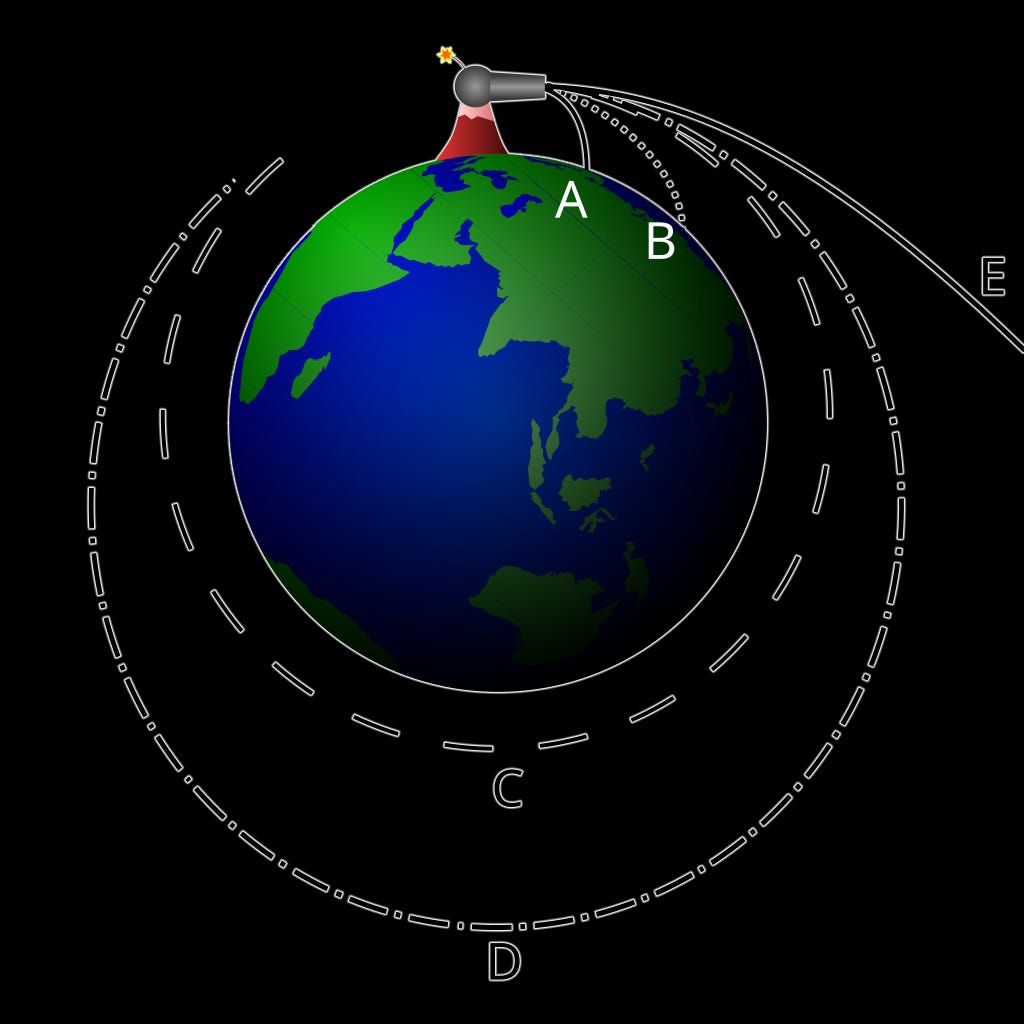
(G = Gravitational constant, M = Earth mass, R = Earth’s radius)
We can calculate that Enterprise’s orbital velocity should be 7.4 kilometres per second.
1,400 kilometres away from the observer, this equates to an angular velocity of 0.3° per second.
For a 180° path across the sky, Enterprise would therefore only be visible for ten minutes. The telescope would need to be tracking to keep the target in frame, but it does not seem to be tracking, nor is it clear that it would even have that capability. After 1.5 seconds, Enterprise would pass through the telescope’s field of view.
However, in First Contact, the Enterprise is not stationary within the telescope’s field. This offers another opportunity to measure Enterprise’s speed and altitude, and it can be tested if they concur with the current findings.
Altitude Estimate by Velocity
For the three seconds that Cochrane observes Enterprise, it is moving. By overlaying the first and final frame of its motion, Enterprise’s velocity can be measured.
We can see that Enterprise almost travels its own length within the three seconds, so its velocity must be about 230 m/s. If we briefly consider Enterprise’s previously calculated angular size of 0.03°, its angular velocity is 0.03° per second, ten times slower than the angular velocity previously calculated.
Orbiting Earth at this low speed, its altitude must be an incredible eight million kilometres.
This orbital velocity would be too low to maintain a stable orbit, because Enterprise would be so far out that Earth would no longer be gravitationally dominant.6 However, we have not considered that an observer on Earth’s surface is in motion as Earth rotates. This might reduce the apparent velocity that Cochrane would observe. We can account for this by calculating the tangential velocity of an observer at a latitude of 46°.
Compensating by adding another 330 m/s, we can claim that Enterprise may be orbiting at 560 m/s. At this speed, Enterprise would only need to be at an altitude of one million kilometres, which is just within where Earth is gravitationally dominant.
When we again consider that Enterprise is 40 degrees above the horizon, it must be be two million kilometres from the telescope.
Rayleigh Criterion
Problematically, at two million kilometres, Enterprise’s angular size would exceed the diffraction limit of Cochrane’s telescope. The Rayleigh criterion defines a minimum angular separation between two point sources to be resolved through a circular aperture. The minimum resolvable angle is the ratio of the wavelength of light to the diameter of the telescope, with a conversion from radians to degrees.
As the mean wavelength of visible light is about 570 nanometres and the primary mirror diameter of the 12” LX200 EMC is 0.3143 metres, the minimum angle that Cochrane’s telescope can resolve is 0.0001°.
With Enterprise two million kilometres from the telescope, it spans 0.00002°, which is less than the minimum resolvable angle of 0.0001° and hence is too small to be resolved in any detail.
Potential Telescope Upgrade
We saw that Cochrane’s telescope had been modified from the classic LX200 with the introduction of a truss, perhaps raising the secondary mirror and extending the focal length. This unknown extension offers some leeway; demonstrating that the telescope may have a greater magnification than the specification LX200.
For the Enterprise to so fit within the telescope’s field of view at a distance of two million kilometres, the telescope would need a magnification of an unprecedented 170,000.
To attain this magnification, a focal length of 4.3 kilometres would be needed.
By considering the ratio of focal length to tube length for the LX200, the length of telescope needed to ensure this magnification can be estimated as 900 metres, which is not sensible for an optical telescope.
Regardless, this is redundant, because the telescope is no wider than any LX200, so this hypothetical extension would not be able to resolve the shape of Enterprise, even if it could display it as a large blurred dot.
Conclusion
Assuming Cochrane’s telescope to have the same optics at the 12” Meade LX200 EMC, there is an inconsistency between Enterprise’s altitude and its velocity. Because the primary mirror diameter at least roughly matches the 12” LX200 EMC, Cochrane’s telescope has a limited resolution and is incapable of observing the Enterprise at a distance where its velocity affords it a stable orbit.
Enterprise being further out than measured by assuming classic LX200 optics is consistent with external shots of the ship not depicting a Low Earth Orbit. The idea of a more distant Enterprise is also consistent with the visible trussed extension present on Cochrane’s LX200. However, no feasible extension would enable the telescope to so clearly observe so far out.
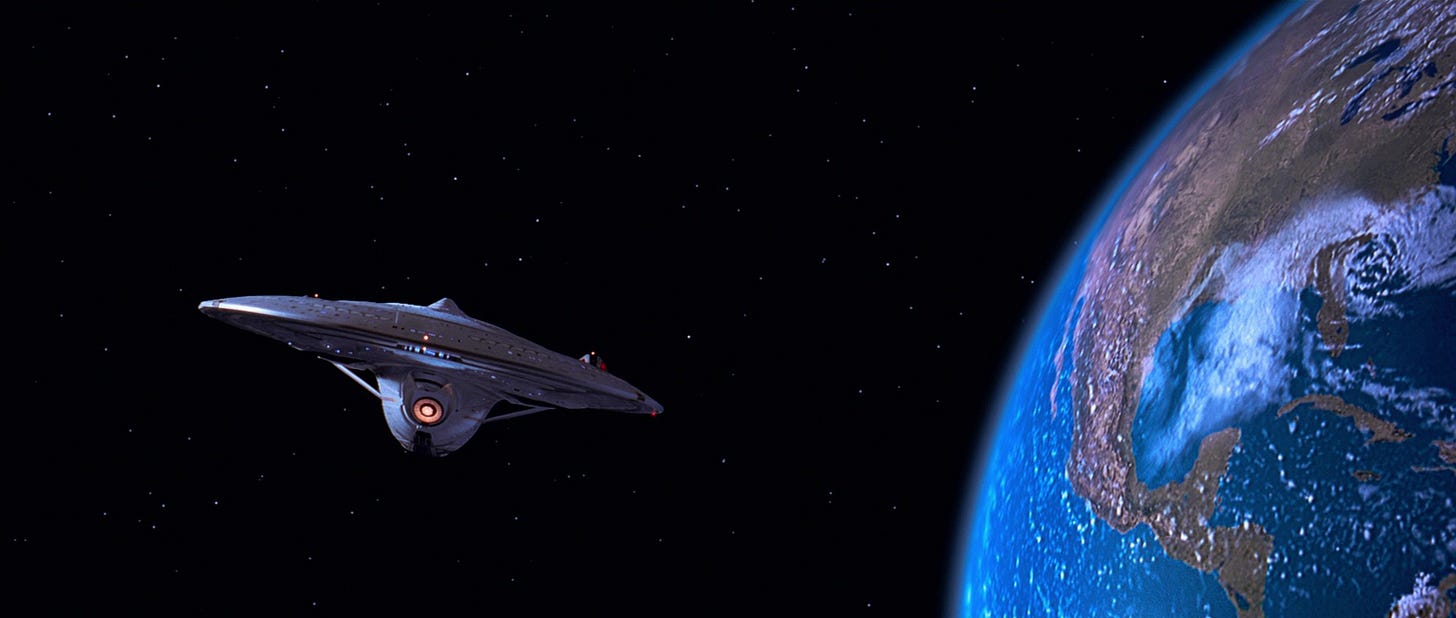
It is possible that Cochrane has exchanged the stock Series 4000 SP26mm eyepiece for one with a shorter focal length to maximise magnification. Yet to magnify a very distant Enterprise, Cochrane’s telescope would need an eyepiece focal length in the microns, which would be practically impossible to manufacture or use.
It seems that the only conclusion which matches all evidence is that Enterprise is not orbiting, but falling.
Appendices
1. 8” Meade LX200 EMC Observes ISS
2. More Fake Stars in Star Trek
The screencap of Enterprise, as observed by Cochrane, failed to plate-solve using Astrometry.net, confirming that the stars are artificial.

This is disappointing decision, because the positions of the stars above Bozeman89, Montana on the fourth of April 206310 can be readily ascertained.

3. Warp Barrier Nonsense
First Contact makes an unexpected leap by claiming the first warp drive to be immediately capable of ascertaining the speed of light, associating light speed with a so-called “warp barrier”.
One might have expected warp drives to begin as an inefficient way of moving at ordinary speeds; evolving to attain high speeds while avoiding relativistic effects such as time dilation, before eventually advancing to the point of exceeding the speed of light. There would be some real precedent to this, as scientists have claimed that sub-light warp drives may be more physically feasible than faster than light .1112 Instead, the first warp drive in Star Trek advances directly to light speed.13
4. Cochrane, the Stereotyped Scientist
Additionally, First Contact confirms that Zefram Cochrane is a symptom of the ‘mad scientist’ trope, in which lone geniuses produce profound discoveries. Cochrane somehow scavenges the presumably intricate, warp drive equipment or manages to manufacture it himself; all within a post-nuclear war environment with extremely limited support. This is not a realistic view of modern science, where breakthroughs are made not by magical geniuses, but expensive collaborative efforts. While the idea of a lone genius was implied in TOS: Metamorphosis, where the character of Zefram Cochrane was introduced, it was not necessarily so and one might have interpreted Cochrane as being a scientist who lead a team of researchers.
5. Anachronisms
First Contact presents a dating conundrum. The Original Series episode Metamorphosis is accepted to be set circa 2265, in which McCoy claims Cochrane to have died 150 years prior, circa 2115 when Cochrane claims to have been 87. This places Cochrane’s year of birth circa 2028. He would be about 35 years old by the events of First Contact, only the actor, James Cromwell, was 56, and visibly so.14
6. Warp Design
Further cementing my dislike for First Contact is the design of the first warp ship, the Phoenix. While I appreciate the creativity in repurposing a Titan II ICBM, it is quite boring to me that Phoenix adopts the standard dual-nacelle architecture, rather than a more unique annular drive. The XCV-330 ship design, first to sport the annular warp drive, was already technically canonised as of STI: The Motion Picture, where it was heavily implied to be named Enterprise.
It is unfortunate that it would be First Contact that would be the ultimate influence on the series Star Trek: Enterprise, which took a similarly unimaginative take on the show’s titular starship, or ‘Akiraprise’.15
I believe an interesting alternative for the first warp ship is the Bonaventure from Star Trek Chronology: The History of the Future.16 Unfortunately, it also lacks an annular warp drive, but some versions do not feature dual nacelles.

The Bonaventure would later be semi-canonised in episodes of Deep Space Nine, predating First Contact. In Keiko’s classroom, a model of the Bonaventure is missing nacelles.


Higher quality photographs of background graphics have since become available, in which the Bonaventure is clearly labelled as ‘Discovery of the Space Warp’.17
One of the Bonaventure physical models can be observed in greater detail in this video where Adam Savage interviews Denise and Michael Okuda.
If you have further interest in the Bonaventure, I suggest reading Dr. Bernd Schneider’s article ‘From the Bonaventure to the Phoenix’ on Ex Astris Scientia.
7. Teased
Lily interrupted Captain Picard as he was about to state Enterprise’s altitude and settle this issue.
PICARD: There's a... There's a new faction that wants to prevent your launch tomorrow morning. But we're here to help you. This may be difficult for you to accept, but you are not in Montana anymore. You are on a ship, a spaceship, orbiting the Earth at an altitude of...
LILY: If you want to help me, get me out of here.
Credits & Citations
Frakes J. Star Trek: First Contact. United States: Paramount Pictures; 1996-11-22.
Meade History [Internet]. [cited 2025 Feb 9]. Available from: https://images.thdstatic.com/catalog/pdfImages/d8/d896da5a-846f-4377-8ca1-56de8bcc5e6c.pdf
Meade LX200 EMC Instruction Manual available from multiple sources:
https://home.strw.leidenuniv.nl/~hoekstra/SP1/Proef_1_files/telescope_manual.pdf
https://www.bhphotovideo.com/lit_files/514162.pdf
https://www.star.bris.ac.uk/bjm/astro-wiki/attachments/31982246/32079952.pdf
I assumed a flat Earth for this figure. It would actually increase to 980 kilometres when we consider that the ground curves down away from the telescope.
International Space Station - NASA [Internet]. Available from: https://www.nasa.gov/reference/international-space-station
Consider the Hill sphere, which for Earth is about 1.5 million kilometres.
Properly, one ought to use the sidereal day here.
ENT 1x24: Desert Crossing
HOSHI: Why Montana? Of all the places the Vulcans could have landed they chose Bozeman, Montana.
T'POL: Humanity's first warp drive was developed there. It seemed a logical place to begin.
ENT 2x02: Carbon Creek
TUCKER: Every school kid knows that Zephram Cochrane met the Vulcans in Bozeman, Montana, on April 5th, 2063. I've been there. There's a statue.
STVIII: First Contact
RIKER: Western hemisphere, North American continent. At a missile complex in central Montana.
PICARD: A missile complex? ...The date? Mister Data, I need to know the exact date.
DATA: April fourth, two thousand sixty-three.
Bobrick A, Martire G. Introducing physical warp drives. Classical and Quantum Gravity. 2021 Apr 20;38(10):105009. Available from: https://iopscience.iop.org/article/10.1088/1361-6382/abdf6e
Fuchs J, Helmerich C, Bobrick A, Sellers L, Melcher B, Martire G. Constant Velocity Physical Warp Drive Solution. Classical and Quantum Gravity [Internet]. 2024 May 2;41(9):095013. Available from: https://iopscience.iop.org/article/10.1088/1361-6382/ad26aa#cqgad26aas1
STVIII: First Contact
RIKER: They should be out there right now. We better break the warp barrier in the next five minutes if we're going to get their attention.
RIKER: Thirty seconds to warp threshold. Approaching light-speed.
TOS 2x02: Metamorphosis
MCCOY: But that's impossible. Zefram Cochrane died a hundred and fifty years ago.
SPOCK: The name of Zefram Cochrane is revered throughout the known galaxy. Planets were named after him. Great universities, cities.
KIRK: Isn't your story a little improbable, Mister Cochrane?
COCHRANE: No, it's true. I was eighty seven years old when I came here.
ENT 1x01: Broken Bow corroborates this, but adds that this must have been less than 144 years, not 150.
FORREST: When Zefram Cochrane made his legendary warp flight ninety years ago, and drew the attention of our new friends, the Vulcans…
Rather than quoting Doctor Cochrane, I think we should listen to his own words from the dedication ceremony for the Warp Five Complex thirty two years ago.
Schneider B. Ex Astris Scientia - The “Akiraprise” Design [Internet]. Ex-astris-scientia.org. 2024 [cited 2025 Feb 9]. Available from: https://www.ex-astris-scientia.org/articles/enterprise_design_comment.htm
Okuda M, Okuda D. Star Trek Chronology the History of the Future. New York Simon And Schuster; 1996.
Lot #659 - STAR TREK: DEEP SPACE NINE (TV SERIES 1993-1999) - Starship Chronology Computer Display [Internet]. Propstoreauction.com. 2019 [cited 2025 Feb 9]. Available from: https://ukm.propstoreauction.com/lot-details/index/catalog/169/lot/47283





